Fort Albion
Introduction
Text-to-speech Audio
Images
Fort Albion historical marker
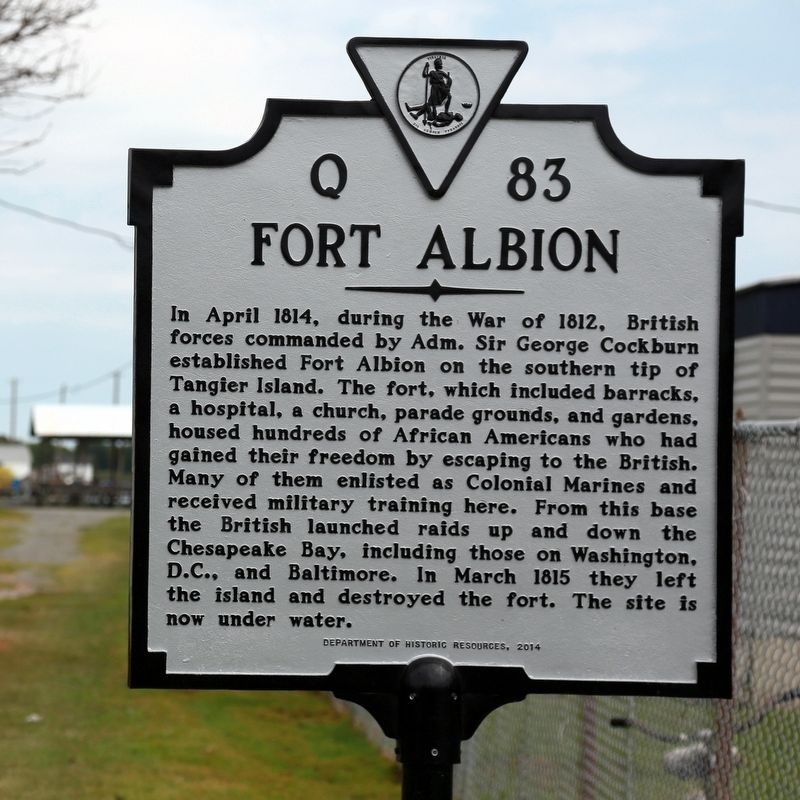
The beaches of Tangier Island
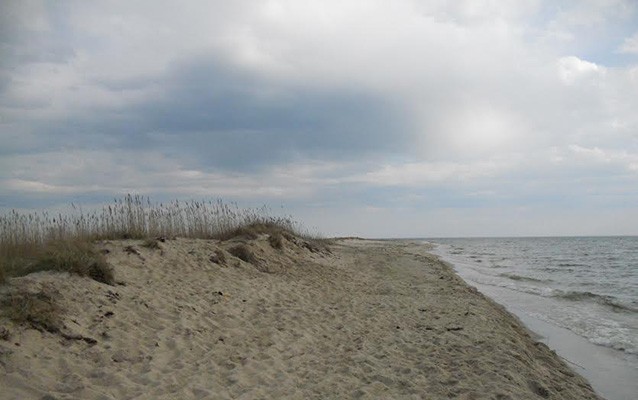
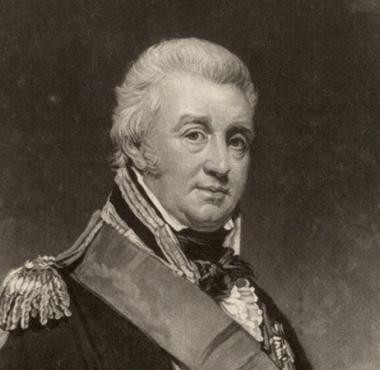
Rear Admiral George Cockburn; Washington, D.C. burns in the background
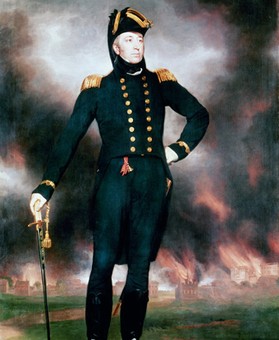
A depiction of a Colonial Marine
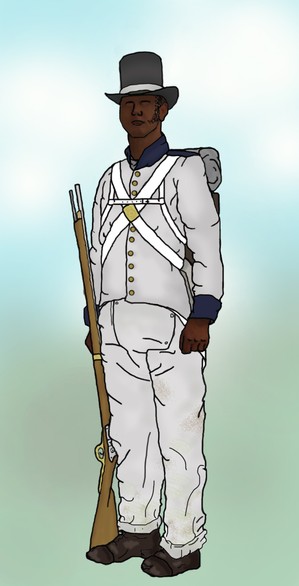
Backstory and Context
Text-to-speech Audio
The United States declared war on Great Britain in 1812 with ambitious goals. The young nation hoped to decisively defeat Native-American and British intrigues in the West, put an end to British depredations against American ships on the high seas, and perhaps even conquer Canada to the north. Focused on defeating Napoleonic France in Europe, the British could afford relatively little resources to a North American front. The time felt ripe for the United States to assert its dominance.
After two years of fighting, the United States instead found itself struggling to protect its own borders. Nowhere was this more evident than in the Chesapeake Bay, where the British Royal Navy effectively blockaded the coast and curtailed American shipping. The blockade kept the American ports of Baltimore, MD and Norfolk, VA closed and threatened the security of the nation’s capital along the Potomac River, Washington D.C.
By the spring of 1814, Britain had grown tired and angry with the American war. Having defeated Napoleon (at least for the moment), Britain was able to turn its attention and supplies to North America. Fueling British anger were destructive American raids on Canada, notably the raid on Port Dover, Ontario. Hoping to punish the Americans, the British determined to step up their activities in the Chesapeake.
With this new strategy came a new commander: Vice Admiral Alexander Cochrane, who assumed command of all Royal Navy activities in North America. An ambitious and aggressive commander, Cochrane’s will in the Chesapeake would be carried out by his subordinate, Rear Admiral George Cockburn. As Cochrane ordered Cockburn in April 1814: “You are at perfect liberty as soon as you can muster a sufficient force to act with the utmost Hostility against the shores of the United States…Their sea port towns laid in ashes and country wasted will be some sort of retaliation for their savage conduct in Canada.”[1]
The logistical hub for the Royal Navy’s activities in Chesapeake Bay was Tangier Island. A small island in the center of the Chesapeake, it offered a deep water port for the Royal Navy, with easy access to both the Upper and Lower Bays. By early 1814, the island served as the British base for its operations in the Chesapeake, as Admiral Cockburn began raiding American towns in the Chesapeake Bay with his fleet and 3,000 veteran infantrymen brought as reinforcements from Europe.
Yet Tangier Island also served as a safe harbor for Black Americans. Hoping to weaken the American economy and morale while bolstering their own ranks, Britain welcomed runaway slaves. The runaway slaves were afforded freedom and transportation to either Nova Scotia or Trinidad. The men were also given the opportunity to enlist in the British Navy. Admiral Cockburn raised and recruited a small Corps of Colonial Marines. Nicknamed “Blue Jackets” for their uniforms, these Black soldiers quickly proved their bravery and worth. As Admiral Cockburn lauded of the Black Marines, “they have induced me to alter the bad opinion I had of their whole Race and I now really believe these, we are training, will neither show want of zeal or courage when employed by us in attacking their old masters.”[1] Several hundred Black Colonial Marines served alongside British forces during the Chesapeake Campaign.
To protect their Tangier Island base, the Black and white British soldiers, sailors, and marines constructed Fort Albion. Relatively little is known about the fort's layout. The fort did include a barracks, hospital, and church. It also contained a number of family homes and gardens, which housed both soldiers and the several hundred Black refugees who fled to Tangier Island. Some refugees stayed on the island, while others were transported to the Caribbean. Fort Albion thus protected both British forces and Black American refugees alike.
The British Chesapeake Campaign ultimately culminated in the successful capture of Washington, D.C. (including the burning of the White House) and the unsuccessful attack on Fort McHenry outside Baltimore (where “our flag was still there”). Shortly thereafter, peace was secured between the United States and Great Britain via the Treaty of Ghent in February 1815. Tangier Island and Fort Albion were evacuated on March 21, 1815. The fort’s structures were burned. Admiral Cockburn declared that “on no account [is] a Single Negro [to] be left, except by his own request,” ensuring the continued freedom of the Colonial Marines and Black refugees from whom Tangier and Albion had been a refuge for liberty.[3]
Rising seas and erosion have swallowed up the land where Fort Albion once stood. The only reminder of Fort Albion today on Tangier Island is a state historical marker on Main Ridge Road.
Sources
1. Stanley L. Quick and Chipp Reid. Lion in the Bay: The British Invasion of the Chesapeake, 1813-1814. Annapolis, MD: Naval Institute Press, 2015.
2. John R. Elting. Amateurs, to Arms! A Military of the War of 1812. New York: Da Capo Press, 1995.
3. James A. Percoco. "The British Corps of Colonial Marines: African Americans Fight for Their Freedom." American Battlefield Trust. Web. Accessed December 14, 2020. https://www.battlefields.org/learn/articles/british-corps-colonial-marines
4. "Tangier Island." National Park Service. Web. Accessed December 14, 2020.https://www.nps.gov/places/tangier-island.htm
5. Charles P. Neimeyer. The Chesapeake Campaign 1813-1814. Washington, D.C.: Center of Military History, 2014. Digitzed. https://history.army.mil/html/books/074/74-5/index.html
J.J. Prats, Historical Marker Database: https://www.hmdb.org/m.asp?m=97720
Virginia Dept. of Historic Resources, NPS: https://www.nps.gov/places/tangier-island.htm
National Park Service: https://www.nps.gov/people/george-cockburn.htm
Wikipedia: https://en.wikipedia.org/wiki/Corps_of_Colonial_Marines
